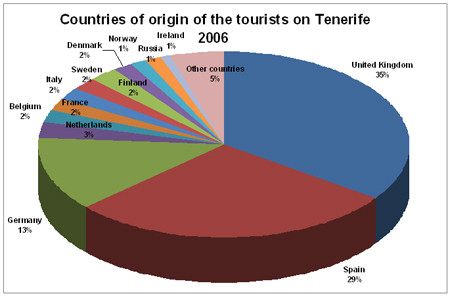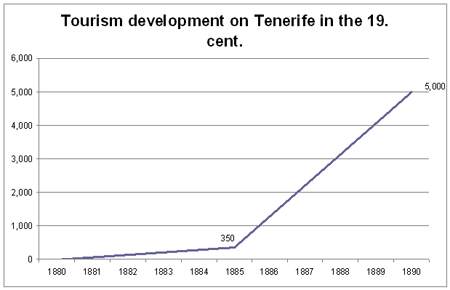4. Mass Tourism
Case study Tenerife (6/8)
Development of Tourism on Tenerife
On the previous pages, we learned that the land cover and land use is changing on Tenerife. In particular, settlements are growing. The reason is tourism, which has been flourishing here partly because of the favourable location and climate. But since when? Since when did sunseekers and recreation- or adventure-seekers start travelling to this Canary island? And where are the millions of tourists from?
In Germany the first flight package tour to Tenerife from a catalogue was evailable in 1956. It was a two day long journey to the Canary Island. This is how the German inrush to Tenerife began. But already in 1885 the first 350 tourists from England visited the worldwide popular holiday island. Since the 1960s mass tourism on Tenerife began, in 1960 there were 73,000 guests, but by 1975 there were already more than 2 million visitors (also see figures).
The development of tourist numbers on Tenerife from 1880 to 2006
Since the 1990s the tourism flow to the Canary Islands has been a continuous enormous boom. In 2006 nearly 5.5 Mio tourists were counted. The international mass tourism mainly focuses on two regions: a northern zone with Puerto de la Cruz at the center and a southern zone with the cities Los Cristianos and Playas de la Américas. Both regions are chosen as holiday destinations by about 80% of all tourists (Naumann 2008).
More than a third of the tourists in Tenerife in 2006 came from Great Britain, 29% from the mother country Spain. German tourists made up 13% the third-strongest tourist group. After these three top positions the other countries of origin rank with their percentages distant. 3% of the tourists on Tenerife came 2006 from the Netherlands, in each case 2% came from Belgium, France, Italy, Sweden, Finland and Denmark. 1% came in each case from Norway, Russia and Ireland. Beyond Europe is this island therefore less visited, other countries added up to 5% of the visitors in 2006.

Own illustration. Data: ISTAC

